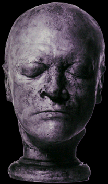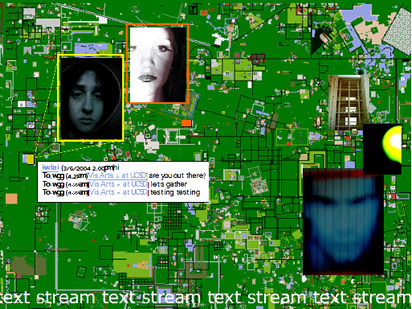December 27, 2004
netzwissenschaft
![]()
Emerging Infrastructures of All (Inter)net Research
Dr. Reinhold Grether's network research | netzwissenschaft site maps the "emerging infrastructures of all (inter)net research endeavours. net.science as an anthropology of connectivity is trying to overcome the constraints of specialist method transfers on net matters. the protuberance of technical networks necessitates a professionalization of human net knowledge. neither the isolation of concepts as in basic research nor the encapsulation of processes as in applied sciences will ever be able to adequately describe the complex autopoiesis of networks. net.science is undoubtedly developing into a scienza nuova of its own right."
Check out his Mobile Art and Virtual Performance research areas.
Posted by jo at 04:45 PM | Comments (0) | TrackBack
October 14, 2004
Liebst du mich Lump

Thoughts run through the net
In Beckett's "Waiting for Godot" nothing happens. Twice. During Beckett's "Liebst Du mich Lump" a lot of things happen. Simultaneously and in different places. The piece adresses the internet-public, only 8 spectators are permitted on location.
"Liebst du mich Lump" takes place in a labyrinthine theatrespace with the walls full of graffiti located in the heart of Berlin-Friedrichshain. But already the delicate, frail nervestream of a Sleeping Beauty in deep sleep, lying in the "skulpturalen Versuchsraum 2" of the "Deutschen Museum" in Munich can change the way the actors act. Thoughts run through the net, also from the internetcafe "Oraniennet" in Berlin- Kreuzberg 36. There, an ironmask is connected with a computer through which users can also manipulate the play with the vibration of their voices. A neuro-virtual "ménage a trois" is being created. Coincidence rules, speech dissolves to a mathematic formula, to oracular words which are put together every evening in a new way.
Opening night: October 19 -November 2, 2004 at 8 pm; Watch the Internetlivestream: www.beckett-pi.de; DSL/Windows.
Posted by jo at 05:15 PM | Comments (0) | TrackBack
September 02, 2004
The Crazy Wisdom Sho

Remote Teleprompting
Unfortunately, there's no video archive on George Coates' web site, which seems to have been abandoned in 2001. However, you can read about The Crazy Wisdom Sho, an experiement in live theater and the Internet in which live performers in a San Francisco Civic Center Theater were onstage surrounded by web-enabled teleprompters. At selected moments, the actors were controlled by online participants who had submitted Crazy Wisdom to the teleprompters via the website.
And, according to George Coates, "(The George Coates Performance Works) produced a show called the "Nowhere Band" that included an inter-actor named Ralph who arrived on-stage via the internet every night at 8:30 PM PST for a five week performance run. This was the first distributed live performance ever to occur as part of a regularly scheduled theater run. Audiences in our theater would see Ralph blow into his pipes to sound a `C' note in Australia establishing the musical key, as the Nowhere Band in San Francisco tuned their instruments to his bagpipe for the first number played in the show. This show premiered at our civic Center theater in San Francisco in 1994." This quote is from "The New Performer" by Sheila A. Malone.
Malone continues: "The idea of space and real are connected with the idea of a time-based experience. The relationship of live characters is absolutely dependent on the interaction with the virtual characters. George Coates takes these ideas of real and hyperreal and completely mesmerizes audiences with the production of "20/20 BLAKE: The Visions Of William Blake." George Coates describes the performance, "at one point we had even hacked a way to make two SGI graphics engines run simultaneous stereographic interactive animation programs enabling audiences wearing polarized glasses to experience stereo 3D illusions of volumetric space interacting in real time with live actors on a stage. (This enabled, for example, a flock of birds to appear to hover over the stage and audiences, swooping down to harass the live actor, chasing the actor around the stage wherever the actor chose to go - in real time)." Here Coates and his company of actors, technicians, and virtual images are merged with the audience into a space created and controlled by the computer and its operators. The definition of performer has changed. But the presence of space and time are consistent common denominators in the performance."
Posted by jo at 06:08 PM | Comments (2)
August 21, 2004
ultra modern - very social
Another Motherboard project, ultra modern - very social is a streaming theatre concept for 2002 and beyond. This space is dedicated to the pursuit of experimental theatre which is somehow modulated and mediated by the intermediary influences of the net, but may also involve communcation appliances such as telephones, mobile phones, walkie-talkies, radio, etc. Our emphasis is on improvisation and experimentation where "here and now" and "there and then" are relative expressions in collaborative networked spaces.
Posted by jo at 11:31 AM | Comments (0)
July 31, 2004
Historically Locating Distributed Performance
2004.04.05 Helen Thorington, writing about an early conference proposal:
The following are examples of distributed performances:
Finding Time (Jesse Gilbert, 2000). Finding Time linked performers on six continents in a series of live musical events, each an hour’s duration.
World Wide Simultaneous Dance (1998, Laura Knott). The project took place simultaneously in twelve countries.
In both examples the performers played to audiences in their performance spaces and to a worldwide Internet audience by means of especially created websites.
I then move on to a brief history, beginning with Kaprow's "Hello Hello" in the mid-60s--about which I can find very little information other than that it linked five sites in a television event. And on to Kit Galloway and Sherri Rabinowitz.
But the history is the not the question for me. Internet works resonate with historical issues. But what I'm beginning to think as I research for the conference is that we may already have witnessed the passing of the (pre)structured presentation of large-scale performance works--I keep thinking, for instance, that while Adrift (1997-2001) was very different from other works produced at its time, it was also very traditional. It was a work by three artists (the senders), in which its audiences had no agency at all--Like radio, like television, they were cast in the role of "receivers."

From the Adrift performance
Now...when did it happen?...the Internet environment is in a far more participatory stage and people-interest runs to works/platforms/
environments in which the former viewer can play an active role. Which may begin to explain why there are really not very many interesting large performance works being produced at this time. Not only is the technology still difficult but the environment is no longer congenial.
Or am I wrong? And if not, what does this do for/to our conference?
I'm going to think about this for awhile. Right now my only thought is that if this is so, the conference itself should reflect it and include the many twists and turns performance has taken in the last years.
Posted by michelle at 01:22 PM | Comments (0)
July 30, 2004
Distributed Cinema
SPEC-FLIC
Described by Adriene Jenick as a "Speculative Distributed Cinema Project....a series of fictional events performed as distributed cinema. SPEC-FLIC is a platform for speculation, creative experimentation and imagination among UCSD students, faculty, staff and the larger public. SPEC-FLIC's title refers to speculative fiction (an area of science fiction that is focused less on new science/tech and more on societal impacts) as well as to the size (a "speck") of the PDA-based video frame that serves as the conduit for this durational collective performance. Originally described as a distributed science fiction soap opera in three phases."

Adriene, tell us about this image.
What is the technology and experience behind this work?
Would you speak about the progression of your work from Paper Tiger television to Desktop Theatre on the internet to Active Campus and Spec Flic on the wireless network?
In your initial post you note these ongoing issues. Can you discuss them by way of examples from your work?
- timing/pacing/duration
this can be thought of from the perspective of participants or from "viewers" - in my experience the "lags" and glitches are all absorbable within the context of a live event. The archiving of this work does not allow for its tension to exist
- relationship of writing to performing, or textuality and orality
this is hugely fascinating to me especially considering the constant evolution of written and spoken language
- use of agitprop to catalyze unexpected engagements
all of my work is engaged within the larger "publc sphere" and cedes a large amount of control to the folks who are engaging with it.
Regarding SPEC-FLIC, your blog shows you in the midst of testing equipment. What are you testing? What is your creative process for working with technology and networks?
Posted by michelle at 09:42 PM | Comments (0)

